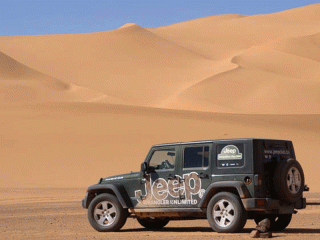The next stop was Ghadames, the former capital of the Touareg people. The city is fully enclosed within its protective walls and consists of four separate familial tribes which are separated from each other by sundown by means of four big gates that are closed in the city. The whole city is also equipped with a very ingenious canal-based irrigation system. These remarkable features, its location, and its history made Ghadames a Unesco World Heritage site.
Leaving Ghadames, we headed to cross the Uwbari sand sea towards Sheba. More than 800 kilometers of desert tracks awaited us without a single refueling point. The chosen route runs parallel with the sand sea, offering ever changing views of desert dunes and giving us a mix of sandy and more rocky driving tracks. In the evening, we built a camp in a magnificent oued to reach the edge of the plateau we had been driving on since Nalut. The views on the great dunes were breathtaking!
From here on, we followed an oil pipe line running next to the track until it disappeared and went underground in the sand-sea…but not without making a victim: a MAN tire was punctured by a piece of scrap metal from the installation, and the 120 kilogram tire needed to be replaced in the desert.
Just in time to replenish our water, food, and fuel supplies, we reached civilization again the next day to pick up the plane group who had just arrived. Well, at least five people from the group arrived as the Tripoli – Sheba flight was overbooked and the rest of the crew would have to arrive the next day … maybe. Inch Allah, so is said to us. Luckily, on Sunday morning, everyone arrived safe and sound, and we were welcomed by Mohammed and his team who would guide us through the Akakus mountain range. Mohammed would be our very experienced desert guide, and he brought a crew of Touareg cooks from Niger. These wizards succeeded in creating superb meals every day with just a minimal amount of supplies in the middle of the desert. Most of us still think back with great joy to the big flat breads, freshly baked in ashes and desert sand.
Then it was off to the Murzuck Sand Sea towards the Algerian-Nigerian border, leading us through the Wadi Barjuj and the Wadi Matkandush which boasts some of the oldest and most preserved rock carvings from prehistoric times. Recent heavy rains, the first in ten years, have flooded the area and make drawings of crocodile, rhino, and giraffe a bit more plausible but in the old days, this Wadi must have been lush and green with a real river in the savannah before it became a desert. We followed the Wadi Matkandush, which is so muddy that the trucks needed to take a large bypass to get to the camp in the Murzuck dunes in order not to get completely stuck in the mud. That evening, with the Murzuck dunes in our views, we enjoyed a meal around the campfire with great views of the sky full of stars: “This is it! This is why we drove that whole distance!”
